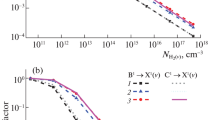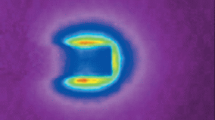Abstract
The relative ease with which a low-pressure hydrogen stream may be heated in an electrical discharge suggests that such a system be considered in current efforts to develop thrusters for spacecraft orbit raising purposes. In this work a detailed model of a microwave discharge in flowing, low-pressure hydrogen is used to interpret and clarify experimental measurements of atom concentration, electron energy, and electron density. The radially averaged, constant-pressure model accurately reproduces the experimental data and also calculated the rates of a number of gas-heating and wall-heating processes as well as rates of energy deposition into coolant and working fluid streams. The calculated gas-heating rates indicate that the gas heating is due primarily to the thermalization of the energetic atoms produced by dissociation of H2 via excitation of theb 3∑ + u state. The calculations also indicate that the energy flux to the quartz tube is significantly influenced by Lyman and Werner band radiation and by heterogeneous atomic recombination processes and, to a much lesser degree, by electron-ion recombination processes. The fraction of power input which is ultimately transferred to the gas stream is a decreasing function of the power input and varies from 0.24 to 0.12.
Similar content being viewed by others
Abbreviations
- A :
-
tube cross-sectional area, m2
- C :
-
molar concentration, g-mol·m−3
- D :
-
diffusion coefficient, m2·s−1
- e 0 :
-
energy of formation of H atoms, J·g-mol−1
- f(j):
-
fractional population of vibrational levelj
- F :
-
molar feed rate, g-mol·s−1
- h :
-
enthalpy, J·kg−1; heat transfer coefficient, J·m−2·s−1·K−1
- J :
-
generalized flux
- k :
-
Boltzmann's constant, 1.3806×10−23 J·K−1; thermal conductivity, J·s−1·K−1
- k i :
-
ionization rate constant, s−1
- k d,j :
-
dissociation rate constant, m3·s−1
- k 21 :
-
recombination rate constant, m6·s−1·g-mol−2
- k 22 :
-
recombination rate constant, m6·s−1·g-mol−2
- L :
-
discharge length, m
- m :
-
atomic mass, kg
- M :
-
molar mass, kg·g-mol−1
- N A :
-
6.022 (1023) g-mol−1
- N :
-
molar flux, g-mol·m−2·s−1
- P :
-
gas pressure, Pa
- q :
-
energy flux, J·m−2·s−1
- R :
-
molar production rate, g-mol·m−3·s−1; tube radius, m; gas constant, J·g-mol−1·K−1
- r :
-
radial coordinate, m
- S :
-
energy production rate, J·m−3·s−1
- T :
-
temperature, K
- v :
-
gas velocity, m·s−1
- z :
-
axial coordinate, m
- 0:
-
feed or reference condition outside
- 1:
-
H2 inside radius of tube
- 2:
-
H2 outside radius of tube
- e :
-
electron
- i :
-
index inside
- v:
-
vibrational
- tr:
-
translational/rotational
- j :
-
index
- e :
-
coolant
- w:
-
wall
- max:
-
maximum
- α:
-
proportionality of radial diffusion rate to ionization rate
- γ:
-
heterogeneous recombination coefficient
- ε:
-
emissivity of quartz; energy of level, J·g-mol−1
- π:
-
3.14159...
- σ:
-
Stefan-Boltzmann constant
References
H. G. Poole,Proc. R. Soc. London 163, 404 (1937).
T. M. Shaw, “Studies of Microwave Gas Discharges: Production of Free Radicals in a Microwave Discharge,” General Electric Technical Information Report No. TIS R58ELM 115, General Electric Microwave Laboratory, Power Tube Division, Palo Alto, California, 1958.
A. M. Mearns and E. Ekinci,J. Microwave Power 12, 155 (1977).
H. Brunet, J. Rocca Serra, and M. Mabru,J. Phys. 42, 1525 (1981).
T. J. Morin, Ph.D. Thesis, Michigan State University (1985), pp. 103–111.
R. Chapman, T. Morin, M. Finzel, and M. C. Hawley,J. Spacer. Rockets 22, 626 (1985).
T. J. Morin, Ph.D. Thesis, Michigan State University (1985) pp. 93–103.
F. C. Fehsenfeld, K. M. Evenson, and H. P. Broida,Rev. Sci. Instrum. 36, 294 (1965).
A. Gelb and S. K. Kim,J. Chem. Phys. 55, 4935 (1971).
T. W. Shyn and W. E. Sharp,Phys. Rev. A 24, 1734 (1981).
G. J. Schulz,Phys. Rev. A 135, 988 (1964).
S. J. B. Corrigan,J. Chem. Phys. 43, 4381 (1965).
M. Cacciatore, M. Capitelli, and M. Dilonardo,Chem. Phys. 34, 193 (1978).
J. M. Ajello, S. K. Srivastava, and Yuk L. Yung,Phys. Rev. A 25, 2485 (1982).
D. Rapp and P. Englander-Golden,J. Chem. Phys. 43, 1464 (1965).
R. T. Brackmann, W. L. Fite, and R. H. Neynaber,Phys. Rev. 112, 1157 (1958).
W. L. Fite and R. T. Brackmann,Phys. Rev. 112, 1151 (1958).
W. L. Fite and R. T. Brackmann,Phys. Rev. 112, 1151 (1958).
M. M. Audibert, R. Vilaseca, J. Lukasik, and J. Ducuing,Chem. Phys. Lett. 31, 232 (1975).
R. Heidner and J. Kaspar,Chem. Phys. Lett. 15, 179 (1972).
P. A. Whitlock, J. T. Muckerman, and R. E. Roberts,J. Chem. Phys. 60, 3658 (1974).
R. J. Spindler, Jr.,J. Quant. Spectrosc. Radiat. Transfer 9, 597 (1969).
Stwalley,Chem. Phys. Lett. 6, 241 (1970);J. Chem. Phys. 63, 3062 (1975).
A. M. Mearns, private communication.
C. E. Hawkins and S. Nakanishi, “Free Radical Propulsion Concept,” NASA Technical Memorandum 81770, Lewis Research Center, Cleveland, Ohio (1981).
Author information
Authors and Affiliations
Rights and permissions
About this article
Cite this article
Morin, T.J., Hawley, M.C. The efficacy of heating low-pressure H2 in a microwave discharge. Plasma Chem Plasma Process 7, 181–199 (1987). https://doi.org/10.1007/BF01019177
Received:
Revised:
Issue Date:
DOI: https://doi.org/10.1007/BF01019177




